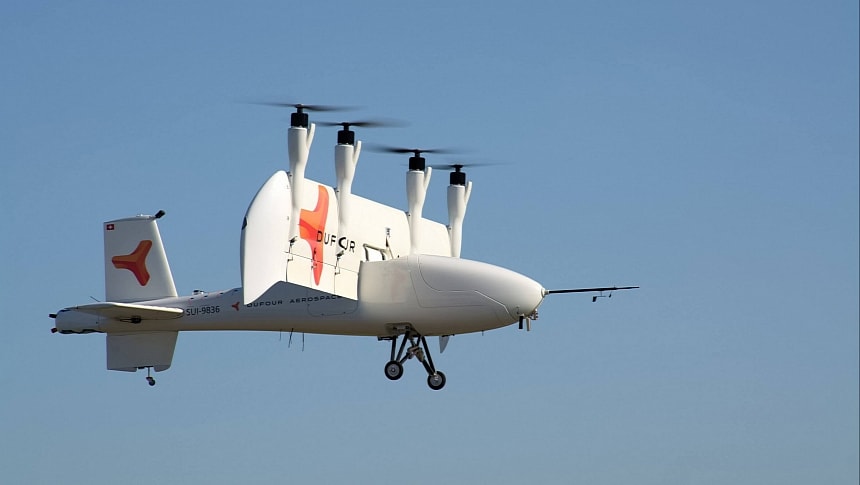A large-scale project in the Swiss Alps aims to confirm that large, fully autonomous drones could revolutionize snow- and mountain hazard research.
Research related to alpine environmental hazards and energy production relies heavily on high-resolution data collection, with cost efficiency also playing an important role. Most of the time, this data-gathering process is conducted with the help of helicopters and fixed-wing aircraft. Drones and eVTOLs (electric vertical takeoff and landing) have also slowly started to make their way in this sector, but only on a small scale.
So far, smaller drones have been used to cover limited areas, which doesn't reflect the full potential of uncrewed air vehicles for this type of data collection operation. But things are about to change. A newly-launched project in the Swiss Alps will test the benefits of large, autonomous eVTOLs in this sector.
The project is led by a Swiss-Austrian consortium. RIEGL will provide the laser scanners, BSF Swissphoto will play a key part in data validation, and SLF (the WSL-Institute for Snow and Avalanche Research) will provide personnel and ensure quality standards.
At the center of this trailblazing project will be not one but two types of aircraft from the same company. These are the AeroMini and Aero2 by the Swiss manufacturer Dufour Aerospace. The AeroMini is a more compact version with a 3-meter (9.8 feet) wingspan, while the Aero2 boasts a larger 6-meter (19.6 feet) wingspan. Both will operate with no pilot onboard.
The series of tests is scheduled to kick off in the following months in Dubendorf, Switzerland. From there, it will gradually expand across the Alpine region over the next two years. If the feedback is positive, this has the potential to pave the way for "autonomous, large area aerial geo data acquisition." The major benefits of this shift have to do with cost efficiency (compared to using traditional, piloted aircraft) and lowering the environmental impact, which is in itself connected to potential mountain hazards.
The Aero2 made waves in the eVTOL industry due to its versatile tilt-wing configuration, coupled with hybrid-electric propulsion for an extended range. The Aero2 can hit an impressive speed of almost 200 mph (320 kph) while cruising as smoothly as a conventional airplane. Its modular propulsion system with an auxiliary power unit allows it to cover up to 497 miles (800 km), which widens its potential area of applications.
Last year, one of these Swiss-made flying machines made its way to the US. The pre-production version of the aircraft, known as the Aero2 X2.2, was sent from Zurich to Oregon. It was the first time when the Aero2 would operate outside of its home country. The aircraft was delivered to US drone operator Spright, which ordered 40 units from Dufour Aerospace, with the option to add 100 more, in what was announced as the largest civilian drone order in the history of America.
So far, smaller drones have been used to cover limited areas, which doesn't reflect the full potential of uncrewed air vehicles for this type of data collection operation. But things are about to change. A newly-launched project in the Swiss Alps will test the benefits of large, autonomous eVTOLs in this sector.
The project is led by a Swiss-Austrian consortium. RIEGL will provide the laser scanners, BSF Swissphoto will play a key part in data validation, and SLF (the WSL-Institute for Snow and Avalanche Research) will provide personnel and ensure quality standards.
At the center of this trailblazing project will be not one but two types of aircraft from the same company. These are the AeroMini and Aero2 by the Swiss manufacturer Dufour Aerospace. The AeroMini is a more compact version with a 3-meter (9.8 feet) wingspan, while the Aero2 boasts a larger 6-meter (19.6 feet) wingspan. Both will operate with no pilot onboard.
The series of tests is scheduled to kick off in the following months in Dubendorf, Switzerland. From there, it will gradually expand across the Alpine region over the next two years. If the feedback is positive, this has the potential to pave the way for "autonomous, large area aerial geo data acquisition." The major benefits of this shift have to do with cost efficiency (compared to using traditional, piloted aircraft) and lowering the environmental impact, which is in itself connected to potential mountain hazards.
The Aero2 made waves in the eVTOL industry due to its versatile tilt-wing configuration, coupled with hybrid-electric propulsion for an extended range. The Aero2 can hit an impressive speed of almost 200 mph (320 kph) while cruising as smoothly as a conventional airplane. Its modular propulsion system with an auxiliary power unit allows it to cover up to 497 miles (800 km), which widens its potential area of applications.
Last year, one of these Swiss-made flying machines made its way to the US. The pre-production version of the aircraft, known as the Aero2 X2.2, was sent from Zurich to Oregon. It was the first time when the Aero2 would operate outside of its home country. The aircraft was delivered to US drone operator Spright, which ordered 40 units from Dufour Aerospace, with the option to add 100 more, in what was announced as the largest civilian drone order in the history of America.







